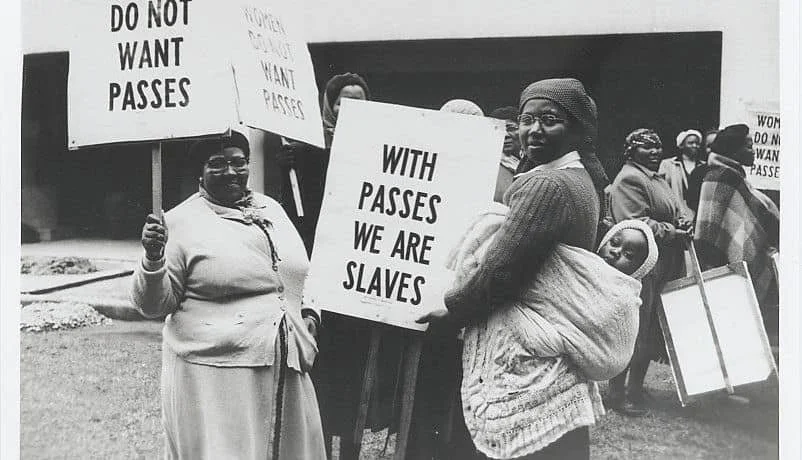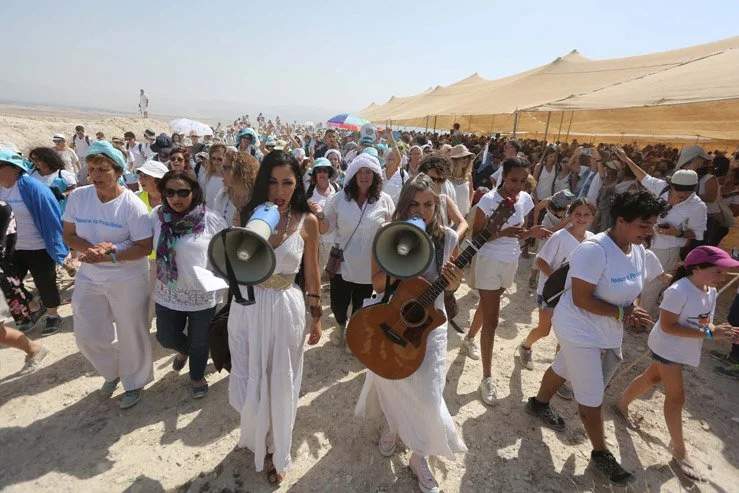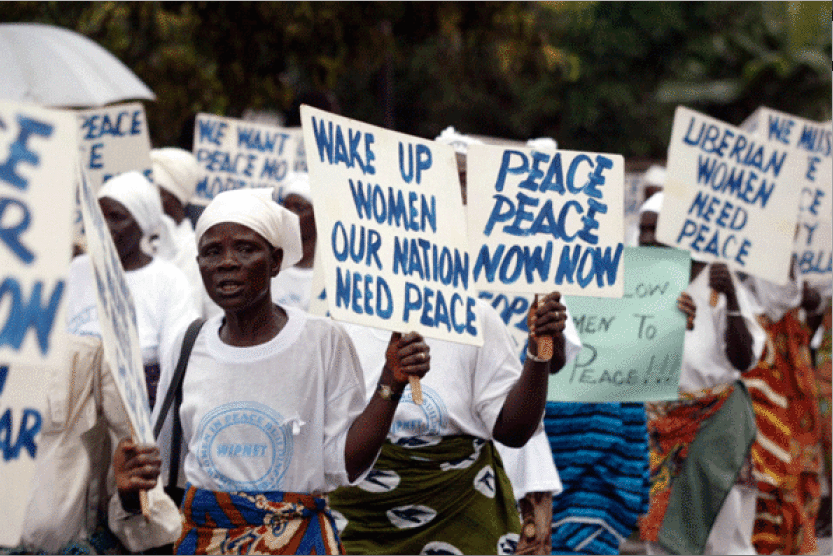Peace Movements Organized by Women
Written by Riyan Buragohain
Women Strike for Peace, 1961
Women Strike for Peace (WSP) is an American women’s peace organization that began with a major protest on November 1, 1961. On that day, between 12,000 and 50,000 women around the world demonstrated against atmospheric nuclear testing. In Washington, D.C., about 1,500 women marched to express concern about the effects of nuclear testing on the health of children.
The organization was officially founded later that year by Bella Abzug and Dagmar Wilson, two key leaders of the protest. WSP was made up mostly of white, educated, middle-class women. Many of its members were mothers who believed they had a duty to protect their children from the dangers of war and nuclear weapons.
WSP used the traditional roles of women– “as mothers and wives”, to call on other women to take action for peace. Their efforts are believed to have helped lead to the 1963 Nuclear Test Ban Treaty between the United States and the Soviet Union.
The Women’s Anti-Pass March, 1956
“You Strike a Woman, You Strike a Rock”- these powerful words come from a famous South African resistance song and have come to symbolize the courage and strength of the women who stood together in the historic Women’s March of 1956.
On August 9, 1956, more than 20,000 women of all races marched to the Union Buildings in Pretoria. They came to protest the apartheid government’s decision to extend the hated pass laws to Black women. Pass laws had long been used to control the movement of Black South Africans, forcing them to carry documents that allowed them to be in urban areas. Those without passes faced arrest and punishment, and the law turned many people into so-called “criminals”.
Until the 1950s, these laws applied mainly to Black men. In 1952, when the government announced plans to make Black women carry passes too, women began organizing in resistance. The idea for a mass protest took shape in 1955 at a meeting of the Federation of South African Women (FSAW), where the call was made. Led by women leaders like Lilian Ngoyi, Helen Joseph, Rahima Moosa, and Sophia Williams-De Bruyn, the 1956 march was peaceful but powerful. August 9 is now celebrated each year in South Africa as National Women’s Day.
Women in Black, 1991
The Women in Black movement began in Belgrade, Serbia, in 1991, during the violent breakup of Yugoslavia. As President Slobodan Milosevic pushed for Serb dominance in the multi-ethnic state, the country fell into a series of brutal civil wars. While Croatia, Bosnia and Herzegovina, and Macedonia declared independence, conflict spread across the Balkans.
In the midst of this turmoil, a group of Serbian women began a silent protest against war and violence. Every Wednesday, dressed in black, they stood together in Belgrade’s Republic Square, calling for peace, demilitarisation, and an end to the bloodshed. Refusing to remain silent in the face of state-led violence, they stood in support of conscientious objectors and offered humanitarian aid to refugees fleeing the war.
Their activism became even more urgent in 1995, after the massacre in Srebrenica. In what is now recognised as the worst atrocity in Europe since World War II, more than 8,000 Bosnian Muslim men and boys were killed by Bosnian Serb forces. Despite government efforts to deny and suppress the truth, Women in Black were among the first in Serbia to publicly condemn the massacre, holding protests under the slogan “Not in our name”.
Chipko Movement, 1973
The Chipko (meaning to “hug” in Hindi) Movement was a peaceful grassroots protest that began in the early 1970s in the village of Mandal in Uttarakhand, India. It was led primarily by rural women who, in response to increasing deforestation, physically embraced trees to stop them from being cut down. This simple but powerful act of hugging trees became a symbol of resistance to environmental destruction.
At the time, government policies favored commercial logging, which led to the rapid loss of forests. Several local communities were dependent on forests for daily needs like firewood, water, and fodder. Women, who were most affected by the changes in their environment, took the lead in fighting back. Led by Gaura Devi, the women of the village stood between the trees and the axes, forming a human shield to protect the forest.
The Chipko Movement quickly gained national attention and spread throughout the Himalayan region. It played a key role in changing India’s forest policies. In 1980, Prime Minister Indira Gandhi imposed a 15-year ban on tree cutting in the Himalayan forests of Uttar Pradesh. The movement also helped inspire the Forest Conservation Act of 1980, which aimed to protect forests across the country.
The Green Belt Movement, 1977
In Kenya during the 1970s, deforestation and environmental degradation were having a deep impact on rural communities. As trees disappeared, desertification increased, and women were forced to walk longer distances to gather firewood. This meant they had less time to care for their families, grow food, or earn a living. In response to these challenges, Professor Wangari Maathai founded the Green Belt Movement in 1977.
The movement began with planting seven tree seedlings on World Environment Day. It then grew into a national and then international effort to restore forests and empower women. Through organized community tree-planting, the Green Belt Movement created “green belts” of trees i.e., long rows of vegetation that helped to combat soil erosion, restore water sources, and improve local environments.
In 1986, the Green Belt Movement expanded its reach by establishing the Pan African Green Belt Network, aimed at teaching conservation and environmental responsibility to leaders across Africa. Consequently, similar tree-planting and community empowerment programs began in countries like Tanzania, Ethiopia, and Zimbabwe. In 2004, Wangari Maathai became the first African woman to win the Nobel Peace Prize.
Women Wage Peace, 2014
Women Wage Peace (WWP) is a nonpartisan grassroots movement that was founded in Israel in 2014 in the aftermath of the Gaza War, also known as Operation Protective Edge. The movement brings together women from all backgrounds, and from across the political spectrum, who are united by one goal: to pressure political leaders to reach a just and viable peace agreement between Israelis and Palestinians.
In October 2016, they led the March of Hope, where tens of thousands of people joined together to call for peace. Then, in October of 2017, Women Wage Peace led a two week Peace Walk which began in Sderot, passed through the Palestinian Territory, and culminated in a 30,000 person rally in Jerusalem. Thousands of Israelis and Palestinians from all across the political spectrum participated in the demonstrations. Supported by the European Union for its effective work, WWP has developed training programs for peace activism, preparing 500 women from a wide range of communities to become leaders in the movement.
Women of Liberia Mass Action for Peace, 2003
In 2003, as the Second Liberian Civil War began, a powerful grassroots movement emerged in Monrovia, Liberia. Led by Leymah Gbowee and Crystal Roh Gawding, the Women of Liberia Mass Action for Peace (WLMAP) united Christian and Muslim women for the first time in Liberian history in a shared demand for peace. In a country with limited civil rights, they spread their message through local radio stations, encouraging women across the nation to rise up for peace. Wearing white to symbolize their cause, the women gathered in public spaces to pray, sing, chant, and hold signs reading, “The women of Liberia want peace now.” WLMAP played a key role in ending the civil war and remained active after the peace agreement was signed, reminding the world that “peace is a process, not an event.” Their work helped shape a new chapter in Liberian history. On January 17, 2006, Ellen Johnson Sirleaf was elected president, making Liberia the first African country to elect a woman as head of state. In 2011, Leymah Gbowee was awarded the Nobel Peace Prize for her non-violent struggle for peace and women’s rights.
Mothers of the Plaza de Mayo, 1977
During Argentina’s brutal military dictatorship (1976–1983), thousands of people were abducted, tortured, and killed in what became known as the “Dirty War.” In the face of terror and repression, a small group of mothers took a courageous stand. Their children who were political activists, students, and workers had disappeared without a trace. In response, these women came together to demand answers.
In 1977, the Mothers of the Plaza de Mayo began gathering in Buenos Aires’ central square, the Plaza de Mayo, in front of the presidential palace. Wearing white headscarves made from their children’s cloth diapers, and carrying photos of their missing sons and daughters, they marched in silent protest. Despite harassment, arrests, and threats, they returned every Thursday at 3:30 p.m., a tradition that continues to this day.
Their peaceful resistance drew national and international attention. Even after the military dictatorship fell in 1983 and constitutional democracy was restored, the mothers remained a strong and vocal force, pushing for justice and human rights reform.
Movement of Women for Peace and Security, 2008
Founded in 2008 by the Tbilisi-based Union of Wives of Invalids and Lost Warriors, the Movement of Women for Peace and Security emerged as a response to the ongoing conflict between Georgia and South Ossetia. The movement was created to support women’s active participation in peacebuilding and decision-making processes, especially among communities directly affected by violence and displacement.
Soon after its founding, the organization held its first Georgian–Ossetian meeting in Baku, Azerbaijan. Women who had been displaced or impacted by conflict came together across national and ethnic lines to share their experiences and plan joint initiatives for peace. From 2008 to 2011, nine dialogue meetings were held in Armenia and Azerbaijan to create meaningful spaces for trust-building between Georgian and Ossetian women.
Beyond dialogue, the movement focused on education and empowerment. Through regular peacebuilding seminars, women learned about their rights, the importance of mutual respect, and how to promote tolerance within and across communities. Every year on September 21, the International Day of Peace, the movement holds a public march, where participants carry white ribbons and flowers as a sign of hope, unity, and peaceful resistance.
The Women’s Peace Army, 1915
Founded on 15 July 1915 in Melbourne, Australia, the Women’s Peace Army (WPA) was a radical socialist movement formed in opposition to all wars. Emerging during World War I, it united women from various backgrounds who rejected militarism and sought to mobilize against the devastation of global conflict regardless of political party lines.
Led by prominent suffragist Vida Goldstein, alongside activists Cecilia John and Adela Pankhurst, the WPA had a strong motto: “We war against war.” Their flag bore the feminist colours– purple, green, and white, linking the peace struggle to the broader fight for women’s rights.
The WPA took part in major peace demonstrations, campaigned against conscription in 1916 and 1917, and supported peace candidates during elections. They also offered humanitarian assistance to those suffering as a result of the war. The Women’s Peace Army left a lasting legacy as one of the earliest and most vocal women-led anti-war movements in Australia. It formally disbanded on 18 December 1919, shortly after the end of World War I.











